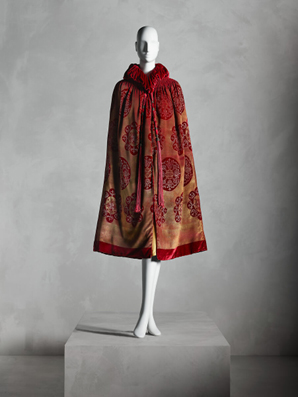Maria Monaci Gallenga (1880–1944) Textile Designer

Working in the early decades of the twentieth century, Italian designer Maria Monaci Gallenga captivated contemporaries with her luminous and richly patterned textiles (L.2018.61.11), which were the basis for striking women’s fashions as well as elements of interior design. Jessica Regan, Independent Curator, February 2024

Maria Monaci Gallenga

Maria Monaci Gallenga

Maria Monaci Gallenga

Maria Monaci Gallenga

Gallenga

Gallenga

Gallenga
Jessica Regan
Independent Curator
February 2024
Working in the early decades of the twentieth century, Italian designer Maria Monaci Gallenga captivated contemporaries with her luminous and richly patterned textiles (L.2018.61.11), which were the basis for striking women’s fashions as well as elements of interior design. Merging historical and contemporary influences from the world of high fashion and beyond, she created designs rooted in traditional aesthetics and techniques but shaped by modern innovations and sensibilities.influence of design reform efforts that began in the previous century, notably the British Arts and Crafts movement. Like the adherents of that movement, Gallenga made fine craftsmanship a central tenet of her work, building her reputation on stunning hand-printed fabrics that mimicked the appearance of Italian Renaissance velvets. Her chosen motifs, however, were inspired by a wide variety of sources, including Byzantine and Ottoman textiles, Renaissance frescoes, and medieval heraldry. Her success lay in the harmonious combination of these disparate elements in designs that reflected the needs of contemporary dress. Especially acclaimed for her tea gowns (L.2018.61.24), mantles, and capes (1980.96), Gallenga created garments with simple cuts and relaxed structures that highlighted the beauty of her textiles and allowed the wearer to move freely.
Though best known for her fashions, Gallenga also aimed to advance Italian decorative arts more broadly, helping to found Arte Moderna Italiana, an organization dedicated to the promotion of contemporary Italian artists working in a variety of disciplines. Many of these individuals gained greater visibility in Gallenga’s gallerylike shops, where she featured their work alongside her own. At a time when the nascent Italian fashion industry had not yet distinguished itself from the influence of Paris haute couture, Gallenga gained international success with garments that were perceived as—and appreciated for—being distinctly Italian.
Beginnings in Rome
Gallenga’s upbringing and early experiences in Rome laid the foundation for a career grounded in admiration for Italy’s artistic past and a desire to nurture a broader creative community. Born in 1880 to a well-established family embedded in Rome’s vibrant cultural life, she became interested in the history of art and design at an early age. During her teenage years she experimented with painting on textiles and eventually began creating garments from fabrics she designed.
Coming of age in a period of increased attention to the history of textile design, Gallenga had access to recently published studies on the subject, which not only encouraged her fascination with antique fabrics but also became sources of inspiration for her own designs. She was also shaped by larger concerns that emerged following Italy’s recent political unification, particularly the desire to stimulate international interest in Italian decorative arts and to define an autonomous artistic identity for the country. These efforts, like Gallenga’s own, were often characterized by allusions to Italian art of earlier eras, above all the Renaissance, widely considered an apex of artistic achievement.
When Gallenga launched her career in the early 1910s, she would have been familiar with fashion and textiles by the house of Fortuny, founded in Venice in 1906. Under the direction of Spanish-born Mariano Fortuny (1871–1949) and his French-born wife and design partner Adèle Henriette Nigrin Fortuny (1877–1965), the Fortuny studio became an important site of experimentation in textile design and production. Among the house’s achievements were fabrics printed with metallic pigments that imitated the glinting effects of metal threads woven into Renaissance velvets (2009.300.468). As Gallenga developed her signature printed fabrics, she likewise emulated these arresting historical textiles, which she appreciated not only for their aesthetic appeal but also for their links to Italian cultural heritage. By referencing Renaissance art, both Gallenga and the Fortunys linked their modern creations with the ingenuity, refined taste, and superb handcraft associated with that era. Gallenga, however, took this connection a step further, developing a brand logo featuring two figures in flowing robes and tall headdresses (L.2018.61.11) that recalled aristocratic early Italian Renaissance dress. This symbol tied her designs to notions of luxury and artistic virtuosity while conveying a recognizably Italian identity.
The first significant display of Gallenga’s work, which included textiles, shawls, and cushion covers, came in 1915 at Secessione Romana, one of a series of annual exhibitions that took place in Rome between 1913 and 1916. These shows highlighted the work of innovative artists, including many with whom Gallenga collaborated, such as glass and tapestry designer Vittorio Zecchin (1878–1947) and costume designer Gino Sensani (1888–1947). In 1918 she opened her first shop in Rome featuring her own designs as well as glassware, metalwork, ceramics, sculpture, tapestries, and embroidery by emerging and established Italian artists.
International Growth
Gallenga’s engagement with the Roman art world led to her participation in international expositions that brought greater attention to her work. At the 1915 Panama-Pacific International Exposition in San Francisco, she exhibited a range of womenswear that included mantles, tea gowns, tunics, and stoles primarily of silk velvet or crepe printed with metallic pigments. For these she was awarded a grand prize and gained acclaim in the American press, which praised her garments for their artisanal quality and lustrous character—and for their divergence from French styles that offered no equivalent to Gallenga’s overtly historicist hand-printed textiles. Interest in Gallenga’s fashions grew in the United States, where they were appreciated for their blend of antique design motifs and coloration with modern fashion silhouettes (L.2018.61.4). By the following decade, her designs were available in cities throughout the country, including Boston, Chicago, New York, and San Francisco.
As her career reached its peak during the 1920s, Gallenga continued to expand her international reach. In 1925 she participated in the Exposition Internationale des Arts Décoratifs et Industriels Modernes in Paris, showcasing furnishing textiles, garments, and accessories in her signature prints. She was again lauded for the luminous quality of her silk velvets printed in shades of gold, bronze, and silver. While Gallenga’s printed motifs were inspired by diverse sources, such as Egyptian figured silks from around 800 CE (L.2018.61.62) and the geometric outlines found in European Gothic tracery (L.2018.61.24), her fabrics suggested to most viewers a distinctly Italian sensibility rooted in the Renaissance, as they echoed the burnished finish and jewel-toned colors seen in that era’s velvets. Following the Paris exposition, Gallenga opened a boutique in the heart of the city, creating a salon-like environment highlighting her own work alongside decorative arts by a rotating roster of Italian artists. By this time her designs were sold in several European cities, including Brussels, London, and Montreux, as well as Rome and Florence. Among her clientele were European aristocrats, socially prominent Americans such as Elsie de Wolfe (1865–1950), and internationally known actresses Lynn Fontanne (1887–1983) and Lillian (1893–1993) and Dorothy Gish (1898–1968).
Design and Production
Gallenga’s marriage of printed patterns with garment silhouettes was responsible for the success of her designs. Like her glistening motifs, the cut of Gallenga’s fashions often referenced medieval and Renaissance dress (2009.300.310). The fluid lines of these earlier styles aligned with the designer’s preference for unrestrictive clothing and harmonized with the columnar silhouette that dominated high fashion during the 1910s and 1920s. To prevent her garments from being purely imitative—from becoming costume rather than fashion—Gallenga responded to current trends, shortening hemlines or adapting contemporary silhouettes while retaining the fundamental character of her designs.
Gallenga’s production process likewise blended tradition and innovation, as she embellished modern industrially made fabrics with hand-worked techniques. By developing her own method for metallic printing on textiles—different from that used at Fortuny—she was able to achieve more subtle shading and a greater range of tones within a single motif. These qualities distinguish her work from that of the Venetian house, yet Gallenga’s fashions have often been misattributed owing to the designers’ shared reference points. Within The Costume Institute’s collection, for example, a circa 1925 velvet tea gown (1975.383.3) was mistakenly attributed to Fortuny when it was acquired in the 1970s; recently, however, the gown was properly credited to Gallenga based on a contemporaneous illustration and close examination of the motif, which reveals the gradated colors typical of her prints.
To execute these signature details, Gallenga devised a system of printing wherein designs were cut from thin wooden sheets that were then mounted to sturdier support blocks. These lightweight components could be created quickly and economically within her own workshop, giving her control over the process. To create her brilliant prints, adhesive was applied to the custom-made blocks, which were then pressed to the surface of the textile. Powdered metallic pigments were then brushed by hand onto the treated areas. In this way, shades of gold, bronze, and silver could be subtly blended into one another, creating an ombré effect.
Unlike their Renaissance counterparts, Gallenga’s fabrics retained a supple hand, well suited to modern fashions, thanks to the flexibility and lightness of her adhesive and pigments. These techniques also allowed her designs to be fabricated relatively quickly without sacrificing the artisanal quality of the end product. She did not generally produce preprinted lengths of fabric that could then be made into clothing or accessories. Instead, her printing was executed after the fabric was cut to shape for a specific design, ensuring that the placement of the printed pattern complemented the cut of the finished garment.
Final Years
Like many designers catering to American and European clients, Gallenga’s business suffered in the Great Depression, and this, in addition to her failing health, led her to scale back her activities. Closing her Paris boutique in 1934, she returned to her original shop in Rome, where she shifted her focus to textiles for use in interiors. When she retired in 1938, her son took over the business, which continued to specialize in interior design until its closure in the late 1970s. Although the Italian fashion industry would not come into its own until the mid-twentieth century and Gallenga herself enjoyed a relatively short career, her success demonstrated the potential for recognizably Italian designs to garner international interest and acclaim.
Citations
Regan, Jessica. “Maria Monaci Gallenga (1880–1944).” In Heilbrunn Timeline of Art History. New York: The Metropolitan Museum of Art, 2000–. http://www.metmuseum.org/toah/hd/glth/hd_glth.htm (February 2024)
Further Reading
Carlano, Marianne. “Maria Monaci Gallenga: A Biography.” Costume: The Journal of the Costume Society 27 (1993): 61–78.
De Guttry, Irene, and Maria Paola Maino, eds. Maria Monaci Gallenga: Arte e moda tra le due guerre. Modena: Palombi Editori, 2018.
Gnoli, Sofia. The Origins of Italian Fashion, 1900–45. London: V&A Publishing, 2014.
Masiola, Rosanna, and Sabrina Cittadini. The Golden Dawn of Italian Fashion: A Cross-Cultural Perspective on Maria Monaci Gallenga. Newcastle upon Tyne: Cambridge Scholars Publishing, 2020.
Orsi Landini, Roberta. “Alle origini della grande moda Italian: Maria Monaci Gallenga.” In Moda femminile tra le due guerre, edited by Caterina Chiarelli, 30–41. Livorno: Sillabe, 2000.
Regan, Jessica, and Mellissa Huber, with a preface by Andrew Bolton. In Pursuit of Fashion: The Sandy Schreier Collection. New Haven, CT: Yale University Press, 2019.
DESIGN YOUR FUTURE TODAY!
Interior Designers Institute was founded in 1984 and is one of the few Interior Design Schools in California offering an Avocational Certificate Course, Associate of Arts Degree in Interior Design, Bachelor of Arts Degree in Interior Design, and Master of Interior Architecture Degree and is nationally accredited and also accredited by CIDA, Council for Interior Design Accreditation.

